 |
Carrot
Scientific name:
Daucus carota
Family:
Araliales: Apiaceae
Pests and Diseases: African armyworm
Bacterial soft rot
Cottony soft rot
Cutworms
Damping-off diseases
Leaf blight
Powdery mildew
Root-knot nematodes
|
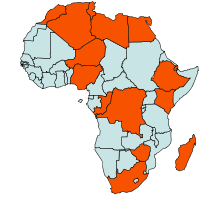 |
| Geographical Distribution of Carrots in Africa |
Nutritive value per 100 g of edible portion
| Raw or Cooked Carrot | Food Energy (Calories / %Daily Value*) |
Carbohydrates (g / %DV) |
Fat (g / %DV) |
Protein (g / %DV) |
Calcium (g / %DV) |
Phosphorus (mg / %DV) |
Iron (mg / %DV) |
Potassium (mg / %DV) |
Vitamin A (I.U) |
Vitamin C (I.U) |
Vitamin B 6 (I.U) |
Vitamin B 12 (I.U) |
Thiamine (mg / %DV) |
Riboflavin (mg / %DV) |
Ash (g / %DV) |
| Carrot raw | 41.0 / 2% | 9.6 / 3% | 0.2 / 0% | 0.9 / 2% | 33.0 / 3% | 35.0 / 4% | 0.3 / 2% | 320 / 9% | 16705 IU / 334% | 5.9 / 10% | 0.1 / 7% | 0.0 / 0% | 0.1 / 4% | 0.1 / 3% | 1.0 |
| Carrot cooked | 35.0 / 2% | 8.2 / 3% | 0.2 / 0% | 0.8 / 2% | 30.0 / 3% | 30.0 / 3% | 0.3 / 2% | 235 / 7% | 17036 IU / 341% | 3.6 / 6% | 0.2 / 8% | 0.0 / 0% | 0.1 / 4% | 0.0 / 0% | 0.7 |
Carrots grow best in a well-drained friable loam free of stones and hard soil clods. It is a short season crop of 2-3 months with the potential of high yields for family food security and fresh market sales. It does well in the cooler areas of Kenya under both rainfed and irrigated conditions.
Seedlings are thinned to 5-8 cm in the rows. Seed requirements (200 plants/m² and 70% germination) for the dominant half-long carrot cultivars used in Asia, are 4-5 kg/ha. For bigger carrots, the density may be reduced to about 100 plants/m².
Examples of Varieties
| "Chantenay" | Fresh market and canning |
| "Nantes" | Fresh market |
| "Amsterdam forcing" | Fresh market variety |
| "Little finger" | Suitable for canning |
| "Nebula F1" | Fresh market |
| "Touchon" | Fresh market |
Carrots that bolt (produce seed) in between normal carrots should be pulled out and fed to livestock. Seed produced this way will not produce good quality carrots. Seed production under tropical highland (above 1200 m) conditions is possible by selecting and harvesting the best quality mature carrot roots and replanting them separately in a corner of the field. Bolting and seed setting soon follows.
Young carrot seedlings are weak and grow slowly. Therefore, it is essential to keep weeds under control for the first few weeks after germination. Cultivate shallowly with a hoe.
Deep cultivation may injure the roots. Weeding and thinning of young plants can be very labour intensive, for which reason most families grow fairly small beds at any one time.
Intercropping
Because of their limited space requirements and early growing habits, carrots are ideal for intercropping between other crops such as tomatoes, lettuce or capsicums and because of their fragrant leaves can help keep pest levels low. Other crops good for intercropping with carrots include garlic, dwarf bean, onion, parsnip, leek, small peas, pea mange-tout (snow peas), and radish. The most profitable example of an association is that of carrots and leeks. Carrots have very deep roots that extract nutrients deep in the soil, whereas leeks have extremely superficial roots, which help the crop to extract nutrients near the soil surface. Moreover, carrots can drive away worms from leeks, while leeks can drive away flies from the carrots (TOF No. 8, page 8).
A good market price can be fetched from young carrots with a fresh top, but leaving the top on dries out the root quickly and reduces the marketing period of the crop. An alternative is to trim the top back to about 2 cm and package attractively.
For mature carrots the tops are trimmed down completely to avoid storage rots before marketing. Carrots can remain in good condition for 100-150 days when the foliage is removed and they are stored at 1-4° C with 95-100% relative humidity. Carrots should be stored separately from other vegetables to prevent a bitter flavour induced by ethylene (a colourless gas with a sweet odour that is produced by many fruits and vegetables that accelerates the ripening process). Generally carrots store better when they are mature and harvested under moist conditions, and undamaged and free of diseases and pests.
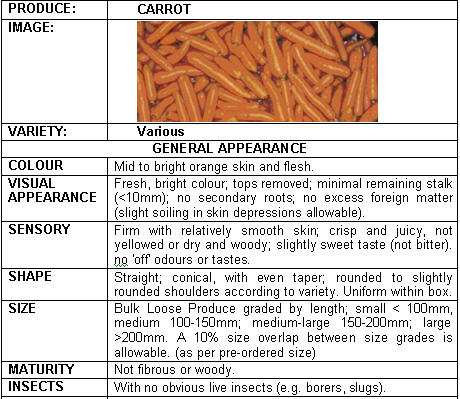 |
| © S. Kahumbu, Kenya |
Cottony soft rot (Sclerotinia sclerotiorum)
The disease is caused by the fungus Sclerotinia sclerotiorum and is characterised by development of soft, watery rot of leaves, crowns and roots. Affected areas become covered with white, cottony fungal growth in which black, irregular, fungal resting bodies (sclerotia) form. The sclerotia enable the fungus to survive for long periods in the soil. This disease is a serious field and storage problem. If diseased roots are packed, extensive breakdown may occur during transit and storage.
- Practice 3-year rotation using cereals and forage grasses.
- Soil flooding is helpful where feasible.
- Do not pack and store damaged and or diseased roots.
- Use clean containers in storage.
- Maintain temperature near 0°C and a relative humidity no higher than 95% during storage.
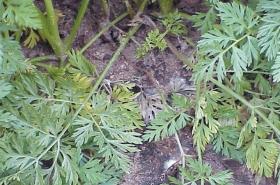
Greyish, white mold forms at the base of stem. Black round structures appear as disease progresses. The disease can extend underground to the root.
© David B. Langston, University of Georgia, Bugwood.org
Leaf blight (Alternaria dauci)
The disease is caused by the fungus Alternaria dauci. Dark-grey to brown, angular spots form on leaves. Surrounding tissue yellows and affected leaves eventually die. Older leaves are attacked first and only in very severe cases are younger leaves affected. Large spots can girdle leaf petioles and kill leaves without spots developing on individual leaflets. During warm moist weather, dying of affected leaves may occur so rapidly that plants appear scorched. This fungus can also cause seedling damping-off. The fungus is seed-borne and survives in the soil crop debris.
- Use resistant hybrids where available.
- Use certified disease-free seeds. In case of using own seeds hot water treat seeds. For information hot water treatment of seeds click here
- Avoid parsley in crop rotation and practice good field hygiene.
- Enhance aeration of crop field by less dense crops and ridge cultivation.
- No or little N-fertilisation.
- Monitor fields regularly to be able to react properly.
- Copper treatments can reduce infection. For more information on copper click here
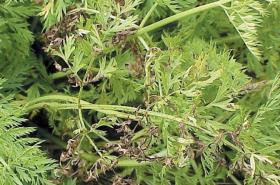
Small, irregular, black to purplish coloured spots. Spots may coalesce to cover the entire leaf.
© David B. Langston, University of Georgia, Bugwood.org
Powdery mildew (Erysiphe polygoni)
The disease is caused by the fungus Erysiphe polygoni (E. heraclei). It is characterised by the development of white, powdery fungal growth on leaves. Affected leaves become chlorotic and eventually die. The fungus is seed-borne.
- Use certified disease-free seeds if using own seeds hot water treat the seeds.
- Practise good field hygiene.
- Practise over-head irrigation where feasible.
- Spray with sulphur based products where acceptable.
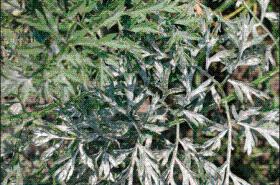
Powdery mildew on carrot caused by Erysiphe heraclei
© www.poljoberza.net
Damping-off on carrot (Phythium sp.)
Damping-off diseases are caused by a complex of plant pathogens (disease inciting agents) including Alternaria spp., Fusarium spp., Pythium spp. and Rhizoctonia solani. These pathogenic fungi may cause rotting of seeds before emergence or death of seedlings after emergence. The most disposing factors are use of non-certified disease-free seeds and excessive watering of seed-beds or field plots.
- Always use certified disease-free seeds. If using own seeds hot water the seeds. For more information on hot water treatment of seeds click here
- Avoid overwatering of seed-beds or field plots.
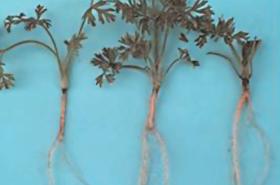
Damping-off on carrot (Phythium sp.)
© David B. Langston, University of Georgia, www.bugwood.org
Bacterial soft rot (Erwinia carotovora var. carotovora)
Erwinia carotovora subsp. carotovora is a bacterium. Bacteria survive in decaying refuse and enter the root principally through cultivation wounds, harvest bruises, freezing injury, and insect openings. After infection, high humidity is essential for progress of the disease. When soft rot occurs in the field, it usually follows a period of water logging in low areas following excessive rain or irrigation. Carrots, potatoes, onions, crucifers, and celery are only a few of the many plants attacked.
The disease causes a soft, watery, slimy rot. The rotted tissues are grey to brown and may have a foul odour. It decays the core of the root. Also prolonged wet weather favours disease development. It is a serious transit and storage problem if affected carrots are not discarded.
In the field, tops of rotted carrots turn yellow and wilt as roots break down.
- Follow a crop rotation of cereals and fodder grasses.
- Destroy by burning of infected plants.
- Carefully handle carrots at harvesting to minimise bruising.
- Discard affected carrots before transport and storage.
- Store carrots in well ventilated places.
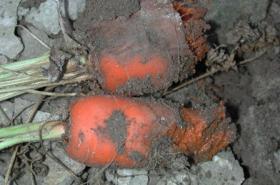
Bacterial soft rot caused by (Erwinia carotovora var. carotovora) on carrot
© Oregon State University
Root-knot nematodes (Meloidogyne spp.)
Various species of Meloidogyne cause galls or swellings on the fleshy tap-root. In warm climates M. incognita, M. javanica and M. hapla are the main species causing problem. The disease is a problem in carrots grown in sandy soils.
- Plant resistant hybrids where available.
- Practice crop rotation with cereals and fodder grasses.
- A 3-year stop for all Apiaceae and Chenopodiaceae crops and a 4 to 5 year stop for legumes is needed to interrupt the life-cycle of these nematodes.
- Soil amendments with neem cake or extracts are recommended.
- Where feasible, practice at least 1 year fallow cultivation.
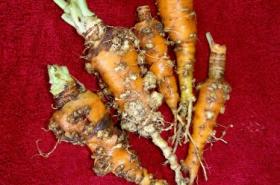
Root knot nematodes (Meloidogyne spp.): Note galling and deformation of carrot roots
© University of Hawaii, www.ctahr.hawaii.edu/nelsons
Cutworms (Agrotis spp)
Cutworms such as the black cutworm (Agrotis ipsilon) and the common cutworm, also known as the turnip moth (Agrotis segetum), attack carrot roots. Feeding on roots causes holes ranging from small and superficial to very large deep holes.
- Conserve and encourage natural enemies. For more information on natural enemies click here
- Plough fields to expose caterpillars to predators and dessication by the sun.
- Destroy weeds and vegetation before planting.
- Flood fields for a few days before planting.
- Spread ash thickly in the seedbeds, around seedlings or mixed with the soil in the planting holes.
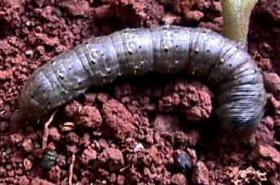
Cutworm (Agrotis sp.) Early instars are about 7-12 mm long. Fully grown caterpillars are 35-50 mm long.
© A.M. Varela, icipe
The African armyworm (Spodoptera exempta)
The African armyworm can cause serious crop losses. Armyworms may cause indirect injury to the taproot by cutting stems and/or consuming foliage above ground.
- Monitor regularly field margins, low areas where plants have lodged, beneath plant debris around the base of plants, on the ground, and underneath the plant leaves. Check daily young crops if conditions are known to be favourable for to the pest.
- Spray Bt or botanicals such as neem and pyrethrum extracts. Spray when caterpillars are small. Once caterpillars are mature (about 3 to 3.5 cm long) they may have cause serious damage and it may no longer be economical to treat the crop. For more information on (neem click here, for pyrethrum click here and for Bt click here)
- Conserve and encourage natural enemies. For more information on natural enemies click here
- Practise field sanitation. For more information on field sanitation click here
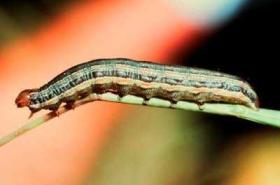
African armyworm (Spodotera exempta). Mature caterpillars measure up to 4 cm.
© University of Arkansas
- Agricultural Information and Resource Centre (2003): Fruits and Vegetables Technical Handbook.
- CABI. (2004). Crop Protection Compendium, 2004 Edition. © CAB International Publishing. Wallingford, UK. www.cabi.org
- East African Seed Co. Ltd. Africa's Best Grower's Guide www.easeed.com
- Herold, W. (1919). A contribution to the knowledge of Agrotis segetum, Schiff. Zeitschrift für angewandte Entomologie, 1:47-59.
- Madge, D., Jaeger, C., Clarke, S. (2003). Agriculture notes. Organic farming: Carrot production and marketing. State of Victoria, Department of Primary Industries. www.dpi.vic.gov.au
- Ministry of Agriculture and Rural Development (Kenya) and Japan International Cooperation Agency (2000). Growing Manual for Local and Export Vegetables. Reprinted by Agricultural Information Resource Centre (Nairobi, Kenya). 274 pp.
- Neergaard P. (1945). Danish Species of Alternaria and Stemphylium. London, UK: Oxford University Press.
- Nutrition Data www.nutritiondata.com.
- Pests of carrot: www.ipm.ncsu.edu
- Sherf, A. F., Macnab, A. A. (1986). Vegetable Diseases and Their Control. 2nd. Edition. A Wiley-Interscience Publication. ISBN: 0 471 05860 2
- University of Illinois Extension. www.urbanext.uiuc.edu
- Amiran Kenya Ltd. seeds@amirankenya.com
- Corner Shop, Nairobi. cls@mitsuminet.com
- East African Seeds Company Ltd. www.easeed.com
- Food Network East Africa Ltd. info@organic.co.ke +2540721 100 001
- Green Dreams. admin@organic.co.ke +254721 100 001
- HCDA. md@hcda.or.ke www.hcda.or.ke +2542088469
- Kalimoni Greens. kalimonigreens@gmail,com +254722 509 829
- Karen Provision Stores, Nairobi. karenstoresltd@yahoo.com +25420885552
- Muthaiga Green Grocers, Nairobi
- Nakumatt Supermarket info@nakumatt.net 020551809
- National Horticultural Research Centre, KARI, Thika. karithika@gmail.com. +2546721281
- Seminis East Africa seminisea@seminis.com
- Simlaw Seeds Co. Ltd. simlaw@kenyaweb.com
- Uchumi Supermarket info@uchumi.com +25420550368
- Zuchinni Green Grocers, Nairobi +254204448240